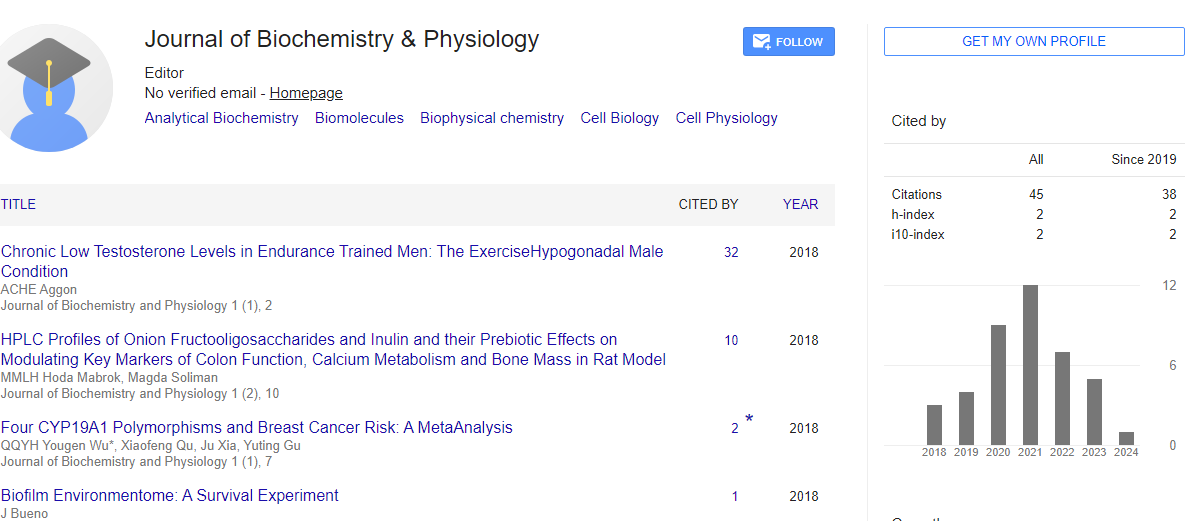Perspective, J Biochem Physiol Vol: 6 Issue: 2
Natures Hidden Resource: Secondary Metabolites and Their Intricate Ecological Significance
Daopeng Fallah*
1Academy of Biology and Biotechnology, Southern Federal University, Rostov-on-Don, Russia
*Corresponding Author: Daopeng Fallah,
Academy of Biology and Biotechnology,
Southern Federal University, Rostov-on-Don, Russia
E-mail: fallahd@sfedu.ru
Received date: 29 May, 2023, Manuscript NoJBPY-23-110490;
Editor assigned date: 31 May, 2023, PreQC No. JBPY-23-110490 (PQ);
Reviewed date: 14 June, 2023, QC No. JBPY-23-110490;
Revised date: 21 June, 2023, Manuscript No. JBPY-23-110490 (R);
Published date: 28 June, 2023 DOI: 10.4172/jbpy.1000138.
Citation: Fallah D (2023) Natures Hidden Resource: Secondary Metabolites and Their Intricate Ecological Significance. J Biochem Physiol 6:2.
Abstract
Secondary metabolites are a fascinating and diverse group of organic compounds produced by various organisms, including plants, microbes, and fungi. This manuscript delves into the world of secondary metabolites, highlighting their structural diversity, ecological roles, and potential applications. We explore their contribution to plant defense mechanisms, human health, and industrial applications, shedding light on the intricate interplay between organisms and their chemical environments.
Description
Secondary metabolites are a fascinating and diverse group of organic compounds produced by various organisms, including plants, microbes, and fungi. This manuscript delves into the world of secondary metabolites, highlighting their structural diversity, ecological roles, and potential applications. We explore their contribution to plant defense mechanisms, human health, and industrial applications, shedding light on the intricate interplay between organisms and their chemical environments.
Secondary metabolites are non-essential compounds that organisms produce beyond their primary metabolic needs. Despite not being directly involved in growth or development, these molecules play crucial roles in various ecological interactions and have significant impacts on human activities.
Structural diversity of secondary metabolites
Alkaloids: Nitrogen-containing compounds found in plants, often with potent physiological effects on humans and animals.
Terpenes: Derived from isoprene units, terpenes contribute to the characteristic scents of plants and have numerous medicinal and industrial applications.
Phenolics: A diverse group of compounds with antioxidant properties, contributing to plant defense against pathogens and herbivores.
Polyketides: Complex molecules synthesized from simple building blocks, with roles ranging from antibiotic production to pigmentation.
Flavonoids: Contribute to flower coloration, UV protection, and antioxidant properties in plants.
Ecological roles of secondary metabolites
Plant defense mechanisms: Secondary metabolites act as chemical deterrents against herbivores and pathogens, enhancing plant survival.
Allelopathy: Plants release secondary metabolites into their environment to inhibit the growth of competing plants.
Communication: Secondary metabolites serve as signals between plants, facilitating interactions with other species.
Biosynthesis of secondary metabolites
Shikimate pathway: A central precursor pathway for aromatic compounds, including phenolics and flavonoids.
Mevalonate pathway: Central to terpene synthesis, producing compounds like carotenoids, steroids, and essential oils.
Polyketide Synthases (PKS): Multi-domain enzymes responsible for the synthesis of diverse polyketide compounds, including antibiotics and pigments.
Non-Ribosomal Peptide Synthetases (NRPS): Complex enzymes involved in the biosynthesis of peptide-based secondary metabolites, such as antibiotics and siderophores.
Engineering and manipulation of secondary metabolite pathways
Synthetic biology: Rational design and engineering of pathways to enhance secondary metabolite production in microbial hosts.
Pathway mining: Genomic approaches for identifying novel secondary metabolite biosynthetic gene clusters.
Heterologous expression: Transferring biosynthetic pathways to suitable hosts for increased production and compound diversity.
Biotechnological applications of secondary metabolites
Pharmaceuticals: Antibiotics, anticancer agents, and other drugs are often derived from secondary metabolites produced by microorganisms.
Food and flavor industry: Terpenes and other secondary metabolites enhance the flavors and aromas of foods and beverages.
Bio pesticides: Secondary metabolites can be harnessed for environmentally friendly pest control strategies.
Drug discovery and development: Secondary metabolites are a rich source of lead compounds for pharmaceutical development.
Antibiotics and antifungals: Secondary metabolites play a vital role in combating bacterial and fungal infections.
Crop protection: Phytochemicals derived from secondary metabolites have potential as natural pesticides and plant growth enhancers.
Environmental remediation: Secondary metabolites can contribute to the degradation of pollutants and toxins in the environment.
Challenges and future directions
Discovery and isolation: Many secondary metabolites remain undiscovered or poorly characterized due to technical challenges.
Synthetic biology: Advances in genetic engineering allow the manipulation of pathways for enhanced production of desired secondary metabolites.
Ecological impact: The ecological consequences of altering secondary metabolite production in plants and ecosystems require careful consideration.
Conclusion
Secondary metabolites continue to captivate researchers and hold immense promise across various biotechnological applications. From unraveling their biosynthetic pathways to harnessing their potential in drug discovery and environmental solutions, secondary metabolites represent a frontier of scientific exploration and innovation.
 Spanish
Spanish  Chinese
Chinese  Russian
Russian  German
German  French
French  Japanese
Japanese  Portuguese
Portuguese  Hindi
Hindi 